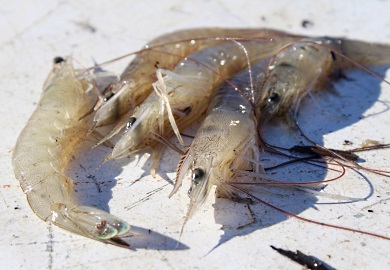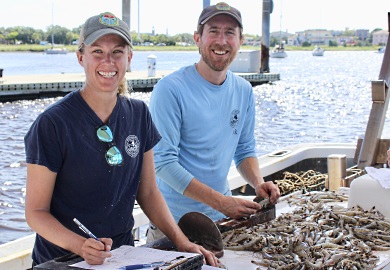May 30, 2019

White shrimp are one of three commercially important shrimp species in South Carolina, along with brown shrimp and pink shrimp. (Photo: E. Weeks/SCDNR)
Barbecue it, boil it, broil it, bake it or sauté it – however you cook it, fresh South Carolina-caught white shrimp are back on the menu.
Commercial shrimp trawling will open in all legal South Carolina waters at 8 a.m. on Wednesday, May 29, 2019. Georgia state waters will open to trawling at the same time.
Hopes are high that 2019 will bring a plentiful harvest after the previous year of relatively poor shrimping. In January 2018, an unusually cold period killed the vast majority of the white shrimp overwintering in South Carolina waters, delaying the 2018 opening of shrimp season until mid-June.
Fortunately, according to regular trawl surveys conducted by South Carolina Department of Natural Resources (SCDNR) biologists, white shrimp numbers appear to have returned to at least the ten-year average, hopefully heralding a better season for the state’s commercial fishery.
“The lack of any commercial shrimp landings from our waters at the beginning of 2018 resulted in enough economic loss to allow the state to apply for a declaration of a failed fishery from the U.S. Secretary of Commerce,” said Mel Bell, director of the South Carolina Department of Natural Resources’ (SCDNR) Office of Fisheries Management. “Following that experience, we are extremely encouraged this year to see how well things seem to be progressing with this year’s crop of white shrimp.”
In an average year, with more typical winter water temperatures, shrimp season opens in full by mid- to late-May, typically after the opening of eight smaller provisional areas in the state’s outer waters. This year those provisional areas opened on April 24, allowing shrimpers to begin harvesting some larger white shrimp from farther offshore while still protecting most of the spawning population closer to shore.

SCDNR biologists Kristin Hamilton and Mike Kendrick measure and count white shrimp aboard a regular trawl survey in 2018. (Photo: E. Weeks/SCDNR)
SCDNR officials set the opening date for shrimp season each year based on the conditions of the shrimp themselves. Aboard both commercial and agency vessels, biologists sample and study white shrimp frequently in late spring. One of the things they’re looking for is evidence that a majority of female white shrimp have already spawned at least once. Opening the season too soon – and allowing trawlers to catch females that have not had an opportunity to spawn – could reduce the size of the fall white shrimp crop, which are the offspring of the spring white shrimp.
South Carolina's commercial shrimp calendar has historically had three peak periods. In the spring, shrimpers typically capitalize on the influx of roe white shrimp, large, early-season shrimp that generally fetch higher prices and generate the most value for fishing effort. The summer months are defined by a peak in brown shrimp, which are similar to white shrimp in size and taste. In the fall and into winter, shrimpers bring in a second crop of white shrimp; the offspring of the spring roe shrimp.
Because white shrimp are a short-lived species that are vulnerable to cold water temperatures and unusually wet or dry summers, their numbers can fluctuate dramatically from year to year. However, they’re also prolific spawners – which means that the populations can quickly rebound even after a poor year or season.



